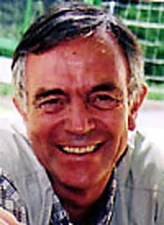Guust Nolet

The 2006 Beno Gutenberg Medal is awarded to Guust Nolet for his pioneering role in the development of digital broadband seismology and for his outstanding contributions to geophysical inverse theory and seismic tomography, which have revolutionized our understanding of the structure of the Earth’s interior.
Guust Nolet received his Batchelor’s degree in 1967 and his Ph.D. degree in 1976, both from Utrecht University. Guust joined the Faculty of Earth Sciences at Utrecht University, and he was promoted to Professor in 1985. Since 1991 he has been a Professor in the Department of Geosciences at Princeton University.
The following quasi-chronological overview illustrates not only his research creativity and versatility but also his tremendous success as mentor for a new generation of seismologists.
As a graduate student in the early 1970ies, he was the first person to obtain reliable measurements of the phase velocities of higher-mode Rayleigh waves. Prior to his pioneering study, analyses of surface waves had been restricted almost entirely to the fundamental mode.
Realizing the severe limitations of hand-digitized photographic recordings, Guust developed, in 1982, the first portable array of broadband digital seismometers, which he used to probe the structure of the upper mantle beneath Western Europe, along a line between Gšteborg (Sweden) and Malaga (Spain). This so-called Network of Autonomously Recording Seismometers (NARS) served as an inspirational example for the PASSCAL instrument pool of the American IRIS consortium, the roving arrays of the Australian SKIPPY project, and the portable array component of EarthScope, also in the USA.
Data from the NARS array showed evidence for strong upper-mantle heterogeneity and topography of the seismic discontinuity near 660 km depth. Realizing that such regional-scale heterogeneity could not be investigated quantitatively using traditional surface-wave methods, Guust switched his attention to short-period body waves and very quickly became a world leader in the then rapidly developing field of 3-D traveltime tomography. In 1985 he introduced into seismology Paige and Saunders’ iterative method for solving millions of linear algebraic equations; this has had a major impact upon the field, and LSQR is now the inversion method of choice in large-scale tomography studies.
In the early 1990ies, Guust’s work in seismic tomography culminated in the discovery that at least some lithospheric slabs penetrate beneath the limit of deep-focus seismicity, and well into the lower mantle. The 1991 publication in Nature (vol. 353, p. 37-43), with Bob Engdahl and Wim Spakman, was a mile stone since it unambiguously resolved a long-standing controversy in the geosciences community regarding the character of solid-state convection in Earth’s mantle1.
Body-wave traveltime tomography is a powerful technique for imaging structure in subduction zones, but it is less useful for resolving upper mantle heterogeneity beneath continental cratons. In 1990, Guust introduced the partitioned waveform inversion method to analyze upper-mantle heterogeneity with multiple S body waves and surface waves. In collaboration with a succession of students, he used this very efficient method to obtain images of upper-mantle structure far superior to any obtained before. With Utrecht graduate student Alet Zielhuis, Guust discovered the remarkably sharp character of the suture separating western Europe from central Europe, known as the Tornquist-Tesseyre zone, and postulated that the root of the Ukrainian shield has been eroded by the injection of volatiles from the subducted proto-Atlantic lithosphere. He and his Princeton graduate students Suzan van der Lee and Sergei Lebedev used the partition waveform method to obtain vivid images of the subducted Farallon plate beneath western North America and of the structure beneath the tectonically complex regions of eastern Asia and the western Pacific.
Despite these successes, Guust has not lost his love for field studies. In collaboration with another Princeton graduate student Richard Allen, he recently conducted a portable passive seismic experiment in Iceland. By employing a combination of partitioned waveform inversion and traveltime tomography, they were able to place strong constraints upon the shallow structure of this classic mantle hotspot.
The partitioned waveform method ignores coupling between surface wave modes, and this approximation becomes increasingly untenable as the scale length of the 3-D heterogeneity of interest decreases. With his Utrecht graduate student Roel Snieder in 1987, Guust developed an innovative and practical method of accounting for mode coupling and scattering, based upon the Born approximation.
This early work with Snieder led directly to Guust’s collaboration with Henk Marquering, Shu-Huei Hung, Tony Dahlen, and others at Princeton, to develop Frechet sensitivity kernels for finite-frequency travel time tomography. In collaboration with his Princeton student Raffaella Montelli and Guy Masters at the Scripps Institution of Oceanography, Guust has recently used these so-called ‘banana-doughnut’ kernels to obtain global images of P-wave velocity, which strengthens the seismic evidence for deep mantle convection plumes obtained from their earlier inversions. As another example of both his creativity and breadth of skill, Guust is now using these plume models to estimate the heat flux from Earth’s mantle, which remains one of the most critical uncertainties in our understanding of the long term thermal evolution of Earth.
It is evident from this abbreviated summary that Guust has spent much of his distinguished scientific career seeking to understand the mantle’s role in shaping the geological features observed at Earth’s surface. Much of Beno Gutenberg’s work had a similar focus, and we believe that he would be an enthusiastic advocate of this nomination, if he were alive today.
